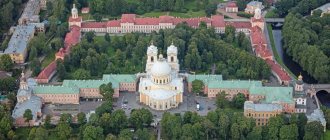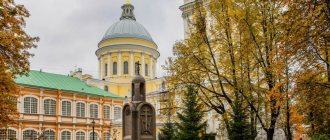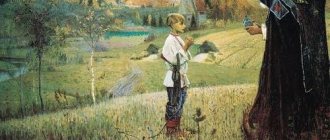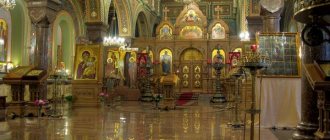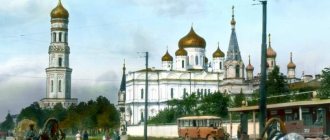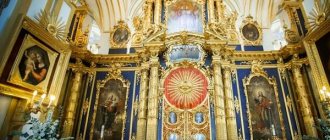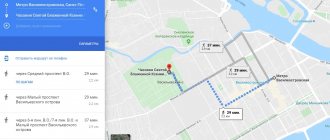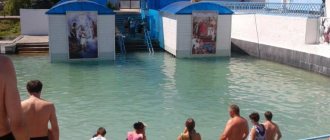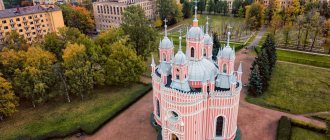I will be happy to tell you about the St. Petersburg Alexander Nevsky Lavra, which I highly recommend visiting during your visit to the Northern capital.
The more you learn about the history of this grandiose monastery, about the fate of its inhabitants, some of whom are now canonized, about the spiritual and missionary activities that are carried out here today, the more you admire it. And it is not surprising that every time I visit the monastery, I always meet both pilgrims and secular tourists (although, go figure who is who) from different parts of the world.
Let me remind you that we have two laurels in Russia. Holy Trinity Sergiev - in Sergiev Posad and St. Petersburg Holy Trinity Alexander Nevskaya. I was once asked what the word “lavra” means. Then I didn’t know what to answer, but now I think it’s worth explaining. In Greek it means “street”, and a large, central one. Gradually the word takes on the meaning of “city of monasteries”. By the way, laurel can only be male. And the word “monastery” itself means “to be secluded, lonely.” I invite you to enter this unique “Street” and get to know it.
Cost of tickets to the necropolises of the Alexander Nevsky Lavra in 2022
- Visit to the 18th century Necropolis and
the Necropolis of Art Masters For Russian citizens, adult ticket - 300 rubles - children of preschool age - free
- Russian schoolchildren and students - 100 rubles
- pensioners of Russia, Armenia, Belarus, Kakhakhstan and Kyrgyzstan - 100 rubles
- adult ticket - 500 rubles
Necropolis of masters of art)
- For Russian citizens, an adult ticket is 150 rubles
- adult ticket - 250 rubles
Current state of the monastery
The Alexander Nevsky Lavra is a completely restored working monastery, an important historical monument of St. Petersburg, where about 70 thousand tourists come annually.
There are 3 hotels for pilgrims in the Dukhovsky and Fedorovsky buildings, as well as refectories where you can eat inexpensively, including during Lent.
There is a library in the Lavra. It was ruined in 1918 and has been gradually restored since 1989. Since 2013, it has been gradually reorganized into a public one, open to the public. Classes are held in the reading room on Thursdays and Saturdays.
The museum offers a collection of church antiquities, icons and vestments, as well as historical photographs.
Under the leadership of the Lavra, a Sunday school was founded, where since 1996 children have been taught the Law of God, applied arts, music, choreography, and participate in services and festivities.
In 2002, the Nevskaya Lavra publishing house appeared, working under the supervision of the monastery. It publishes the city's church newspaper, as well as theological, moral and ecclesiastical non-fiction works.
Several workshops were founded on the territory of the Alexander Nevsky Lavra. The main one is icon painting and restoration. It was founded in 1997, and initially the craftsmen worked mainly on painting icons, developed distinctive features, and later added restoration work.
The jewelry workshop has been operating since 1998; over the past years, the craftsmen have established production and combine traditions and modern technologies. The Lavra employs seamstresses who produce church vestments.
In addition to products for souvenir shops, the porcelain workshop develops items for church purposes, for example, a damask with the face of St. Alexander Nevsky. With the permission of Bishop Nazariy of Vyborg, a pottery studio was created.
History of the Alexander Nevsky Lavra in St. Petersburg
It is believed that on July 15, 1240, at the place where the Black River (now Monastyrka) flows into the Neva, a battle between the squad of Prince Alexander Nevsky and the Swedes took place. In memory of those events, as well as in honor of the victory over the Swedes in 1704, Peter I decided to build a monastery here and gave it the name - Holy Trinity Alexander Nevsky Monastery. Prince Alexander Nevsky was canonized by the church for his good deeds for the Fatherland. The people called the monastery Alexander's Temple.
The monastery was founded in 1710 according to the design of Domenico Trezzini and I. Starov. In 1712, the first buildings appeared next to the monastery. A wooden Annunciation Church and chapel were built. In 1713 the church was consecrated. The monastery settlement is being built up.
According to the project, the monastery complex included churches, cells (monks’ living rooms), the metropolitan’s chambers and other buildings. The buildings were built in a “rest” - the letter P with churches in the corners. A garden with a flower bed was laid out on the territory of the monastery.
The main building of the monastery is located near the Monastyrka river. I. Starov also completed the design of the Church of the Mother of God of All Who Sorrow Joy - the Gate Church, which was so named because of its location above the gates of the monastery.
One of the first buildings of the monastery is the Church of the Annunciation, located on the right bank of the Monastyrka (architects D. Trezzini and T. Schwertfeger, 1724). The church building has survived to this day. It was built on the site of the wooden Annunciation Church. The church has a rectangular plan and is decorated with pilasters. Topped with an octagonal dome on a high drum. It was here that the relics of St. Alexander Nevsky were originally transferred. Here are the ashes of Anna Leopoldovna, Alexei Razumovsky, Alexander Suvorov.
In the middle of the 18th century, several more buildings were built, including the Metropolitan House, Seminary, and Prosphora buildings (architect M. D. Rastorguev). I. Starov also designed a round square in front of the entrance to the monastery territory.
In 1720, a printing house was opened at the monastery. Later, the monastery housed a seminary, which was transformed into the Theological Academy, which still operates today. By decree of Paul the First in 1797, the monastery acquired the highest status - the status of a monastery.
Abbots and governors
- Theodosius (Yanovsky) (1712 - 1721)
- N
- Varlaam (Golenkovsky) (1716 - 1721)
- Hilarion (Markov) (1721 - 1727)
- Veniamin (Falkovsky) (1727 - 1730)
- Simon (Tikhomirov) (1730 - 1732)
- Gervasy (Korda) (1732 - 1737)
- Dosifey (Lebedevich) (1737 - 1745)
- St. Sophrony (Kristalevsky) (1746 - 1753)
- Nikon (Krasovsky) (1753 - 1757)
- Jacob (Palashkovsky) (1757 - 1759)
- Ioannikiy (Brodnetsky) (1759 - 1761)
- Sylvester (Yunitsky) (1761)
- Gury, abbot. (1761 - 1762)
- Clement (Beloshapkin) (1763 - 1765)
- Hilarion (Maksimovich) (1768 - 1774)
- Ambrose (Ginovsky) (1774 - 1781)
- Afanasy (Volkhovsky) (1781 - 1788)
- Josaph (Klokov) (1788 - 1792)
- Jonah, abbot. (1792 - 1794)
- Gerasim (Knyazev) (1794 - 1795)
- Melchizedek (Short) (1795 - 1797)
- Joasaph (Chapuzhnikov) (1797 - 1799)
- Anthony (Znamensky) (1799)
- Ambrose (Protasov) (January 8 - March 1800)
- Israel (Zvegintsev) (1804 - 1808)
- Veniamin (Besnovsky) (1808 - 1809)
- Porfiry (Kirillov) (1809 - 1810)
- Gideon (Fedotov) (1810 - 1819)
- Tobias (Moiseev) (1819 - 1829)
- Palladium (Belevtsev) (March 4, 1829 - October 16, 1842)
- Aaron (Petrov) (1842 - 1843)
- Veniamin (Moracevic) (1843 - 1853)
- Iriney (Bogolyubov) (September 30, 1853 - January 1860)
- Nikanor (Ilyinsky) (1860 - 1863)
- Herman (Ossiecki) (1863 - 1866)
- Polycarp (Honorsky) (1866 - 1867)
- Yuvenaly (Polovtsev) (1867 - 1871)
- Philip, archimandrite (1871 - 1873) i/o
- sschmch. Procopius (Titov) (May 1917)
- sschmch. Procopius (Titov) (January - April 1918)
- Gennady (Tuberozov) (April 11 - August 14, 1918)
- Artemy (Ilyinsky) (August - October 1918) acting
- Nikolai (Yarushevich) (December 14, 1919 - March 1920) acting
- Joasaph (Zhurmanov) (July - September 1922) acting
1935 - 1994 - Lavra closed
- Nazariy (Lavrinenko) (October 25, 1996 - April 17, 1997)
Trinity Cathedral of the Alexander Nevsky Lavra in St. Petersburg
The Trinity Cathedral of the Alexander Nevsky Lavra, built in 1776–1790, is the main one in the ensemble of the monastery. Located between the Dukhovsky and Fedorovsky buildings, decorated in the style of classicism. The cathedral is decorated with sculptural compositions (architect F. Shubin). On the main façade there is a six-column portico with a triangular pediment. The cathedral has a cruciform plan. The interior is divided into three naves by massive pylons supporting the vaults. Italian and Russian marble was used for the iconostasis. The bronze “royal gate” surprises with the elegance of its design.
The Trinity Cathedral contains the relics of St. Alexander Nevsky, transferred here in 1989. Trinity Cathedral is still in operation today.
Time of upheaval: 20th century.
By the beginning of the 20th century. The monastery, where more than 130 monastics had already labored, was one of the richest; in addition, it was famous for its shrines and unique history. The Lavra, as conceived by its founder, Peter I, carried out an enormous social service, spending most of its considerable income on charity: there was an almshouse for crippled soldiers (since 1714), a “House of Charity” for the poor, and the monks helped the women’s diocesan school. And when World War I began, a mobile hospital was sent to the front, and another one was opened on the territory of the monastery.
This is how the Lavra greeted the year 1917. Of course, the new Bolshevik government could not help but persecute the monastery, which was so closely associated with the “old regime.” First, they took away all the premises, except for the church ones, then came the turn of the churches, the opening, and the “requisition” of the relics of the Blessed Virgin Mary. Alexander Nevsky, which ended up in the museum, finally - the destruction of the unique Lavra cemeteries, preserving the memory of the history of the country.
The spiritual situation in the monastery also turned out to be difficult: since 1922, it was captured by supporters of the renovationist schism, to which many monks voluntarily submitted. Only a year later the Lavriots were able to return to the Patriarchal Church.
And on the night of February 18, 1932, the monastic community ceased to exist, as all the brethren who were still at large were arrested.
A difficult time of persecution began, the destruction of the memory of the history of the monastery and the city: the premises of the monastery were occupied by various Soviet institutions and hostels. Many of them continued to operate here until the early 2000s.
However, since 1957, it was possible to return the Trinity Cathedral, where regular services resumed, although it was then considered a parish church. Only in 1996 did the revival of monastic life begin, and on April 18, 2000.
All the previously selected buildings were transferred to the restored monastery. The time of persecution is over.
Necropolis of the Alexander Nevsky Lavra
On the territory of the monastery in 1716, the Lazarevskoe cemetery was founded, where the Church of St. Lazarus was built. V. Sheremetev, F. Uvarov, D.I. are buried in the Lazarevsky necropolis. Fonvizin, M.V. Lomonosov, D. Kvarneghi, A.N. Voronikhin. HELL. Zakharov, J.F. Thomas de Thomon, C. Rossi, A.V., M.I. Kozlovsky. N.M. rests at the Novo-Lazarevskoye cemetery. Karamzin, I.A. Krylov, V.A. Zhukovsky, F.M. Dostoevsky, M.I. Glinka, M.P. Mussorgsky, N.A. Rimsky-Korsakov, P.I. Tchaikovsky, A.A. Ivanov, B.M. Kustodiev, V.I. Demut-Malinovsky, B.I. Orlovsky, P.K. Klodt, V.F. Komissarzhevskaya, N.K. Cherkasov and other famous figures.
Later, the Tikhvin Cemetery (1823) joined the Alexander Nevsky Lavra. Both cemeteries are combined into the Necropolis. Then, in 1861, the Nikolskoye cemetery also became part of the Necropolis. After the reconstruction of Nevskaya Embankment in the 1960s, the Nikolskoye cemetery was significantly reduced in size. The historian L.N. was buried here. Gumilyov and the first mayor of the city A.A. Sobchak. Nikolskoye Cemetery is currently the only active burial site at the Alexander Nevsky Lavra.
In 2002, an equestrian monument to Prince Alexander Nevsky (sculptor V. G. Kozenyuk) was unveiled on the square in front of the monastery. The main holiday of the cathedral is September 12 - the day of the transfer of the relics of St. Alexander Nevsky.
The Alexander Nevsky Lavra is one of the most beautiful architectural ensembles of St. Petersburg. Tourists come to look at the beauty and severity of the monastery buildings and bow their heads before the outstanding figures of Russia who rest here. The Alexander Nevsky Lavra has not lost its spiritual role, despite all the persecutions of Soviet times, and functions as a monastery today.
Bells ringing over St. Petersburg
I tried to tell you about a wonderful place - the spiritual heart of the Northern capital - the Alexander Nevsky Lavra, which I myself love very much.
A special feeling arises here in the winter twilight, when the bells call you to the all-night vigil.
You walk along the paths of the park, called the Communist Square, and previously called the parterre garden, and you understand that here, in close proximity to the noisy Nevsky Prospekt, you are completely removed from all this fuss. There is only the eternal sky, the singing of bells and a beautiful temple, in which you will now light a candle and again feel the loving, warming gaze of the Mother of God coming from her wondrous icon “Neva Quick to Hear”. Probably, it is moments like these that help us become a little kinder and finally hear the voice of our own hearts.
Sunday school at the monastery
Sunday school “Unexpected Joy” appeared in 1996. More than 150 children from 5 to 15 years old study there. The education system consists of three levels, preschool, primary and secondary.
Among the disciplines taught to children are the Law of God, creative and musical activities, choral singing, Church Slavonic language, history and others. Students not only attend lessons, but also participate in worship services, conversations and creative events: Christian exhibitions and festivals.
Conversations with clergy, as well as handicraft classes, are organized for parents. The Sunday school organizes trips and excursions and a summer camp for children on Lake Ladoga.
Divine services
| Holy Trinity Cathedral | |||
| Brotherly prayer service | Morning service, at which all the brethren who are not engaged in obedience are present | Mon-Sat | 6.00 |
| Midnight Office | Night service dedicated to the second coming of the Lord | Mon-Sat | 6.20 |
| Early liturgy | The main service at which the sacrament of the Eucharist occurs | Sun | 7.00 |
| Late Liturgy | Sat-Sun, major holidays | 10.00 | |
| Evening service | Occurs at nine o'clock in the afternoon, towards sunset | daily | 17.00 |
| Akathist to the Sweetest Jesus | Sun | 15.00 | |
| Akathist to the Mother of God before the icon “Neva Quick to Hear” | Sat | 14.00, 15.00 | |
| Akathist to the Holy Blessed Grand Duke Alexander Nevsky | Mon-Wed, Fri | 14.00 | |
| Akathist to St. Nicholas the Wonderworker | Thu | 14.00 | |
| Church of the Holy Blessed Prince Fyodor of Novgorod | |||
| Late Liturgy | Mon-Fri | 10.00 | |
| Evening service | Occurs at nine o'clock in the afternoon, towards sunset | Sun-Thu | 17.00 |
| Gate Church in honor of the Icon of the Mother of God “Joy of All Who Sorrow” | |||
| Early liturgy | The main service at which the sacrament of the Eucharist occurs | Mon-Sat | 7.00 |
Monastery pilgrimage center
The pilgrimage service began work in 1999. Its purpose is to organize pilgrimage trips and excursions in St. Petersburg, Russia and abroad.
The purpose of such trips is education, studying the history and heritage of the Russian Orthodox Church and Christianity, the way of life of monasteries and parishes, attractions, church heritage and museum exhibits of historical and religious value, attending services and performing the sacraments.
Trips are made not only within the territory of the Russian Federation, but also beyond its borders. The pilgrimage center helps familiarize believers with shrines in Italy, Gracia, Jerusalem, Egypt, Germany and other countries.
Professional guides and Orthodox escorts go on all trips with pilgrims. Pilgrimage trips are aimed not only at enlightenment, but also at strengthening the spirit and faith.
